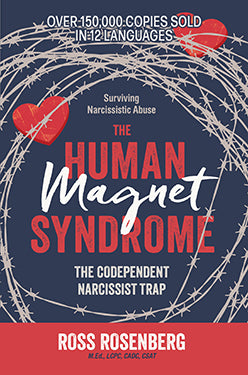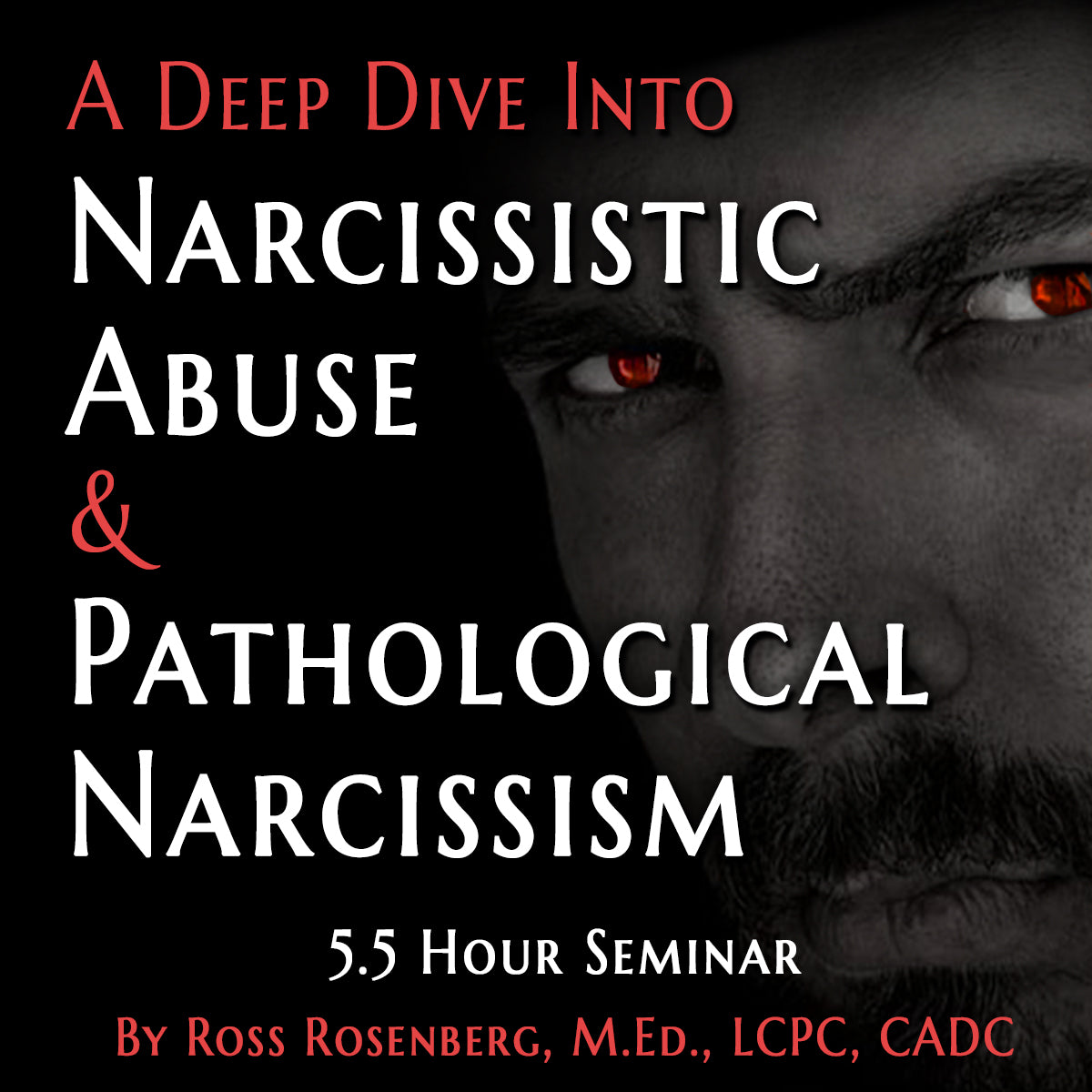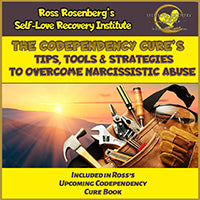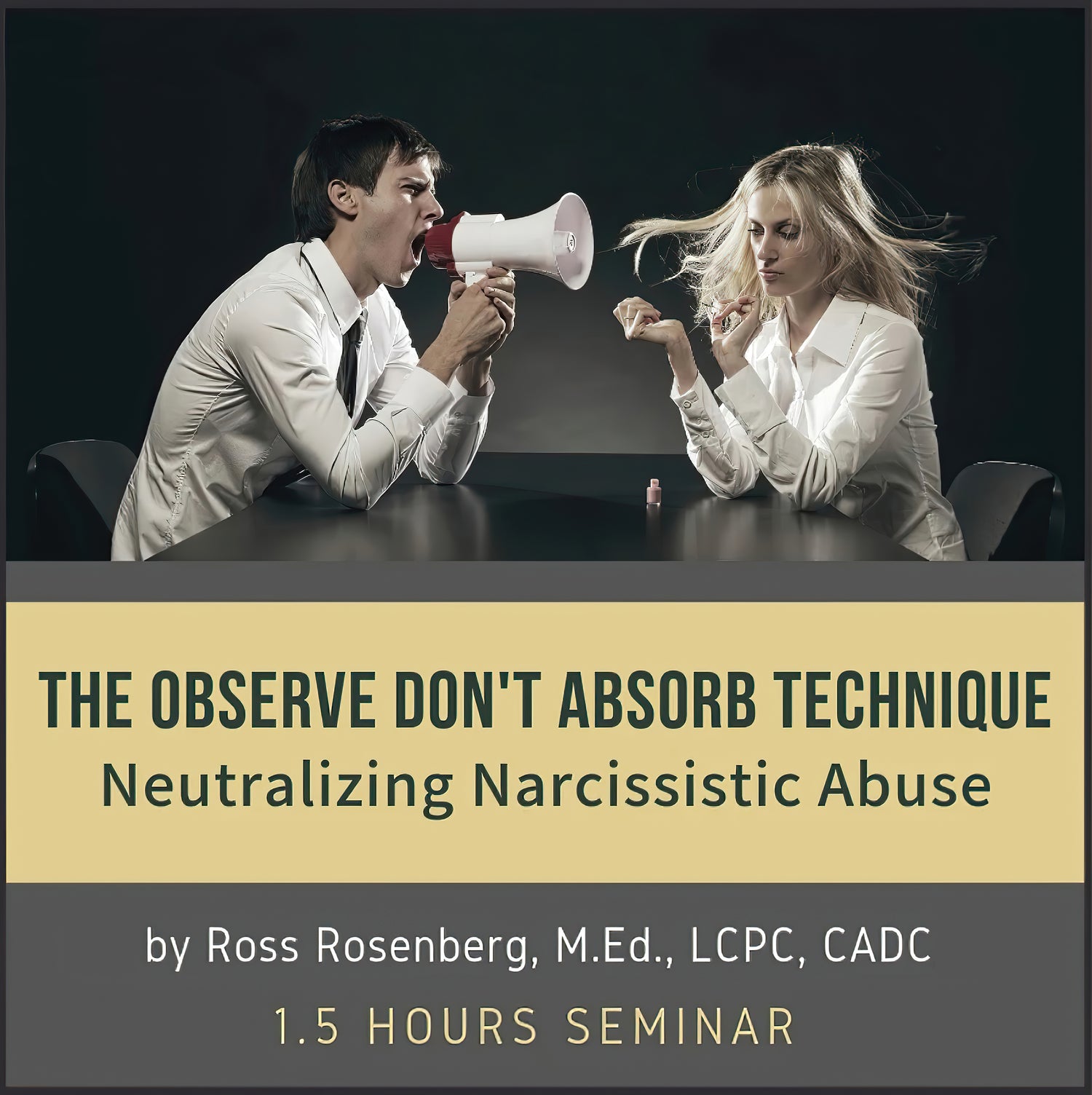Pathological Narcissism & Narcissistic Abuse
Pathological Narcissism
Although pathological narcissism is not a new term, it is used in The Human Magnet Syndrome book to represent a person with one of four disorders. Pathological narcissists are people who fit the diagnostic criteria for either Narcissistic, Borderline, or Antisocial (Sociopathy) Personality Disorders, and/or active addicts. Despite the many differences between these four disorders, they all share core narcissistic personality, thinking, and emotional and interpersonal characteristics.
To varying degrees, all pathological narcissists are selfish, self-consumed, demanding, entitled, and controlling. They are exploitative people who rarely or selectively reciprocate any form of generosity. Pathological narcissists are only empathetic or sensitive to others when doing so results in a tangible reward for themselves and/or when it makes them feel valued, important, and appreciated. Because narcissists are deeply impacted by their personal shame and loneliness but are consciously unaware of it, they do not end their relationships. Positive treatment results are rare for narcissists.
Borderline Personality Disorder (BPD)
BPD is characterized by volatile moods, self-image, thought processes, and personal relationships. When unable to regulate their emotions, borderlines tend to engage in wild, reckless, and out-of-control behaviors such as dangerous sexual liaisons, drug abuse, gambling, spending sprees, or eating binges. A prominent feature of BPD is the inability to regulate mood, which is often referred to as mood dysregulation. Symptoms include rapidly fluctuating mood swings with periods of intense despair and irritability and/or apprehension, which can last a few hours to a few days. Borderlines become overwhelmed and incapacitated by the intensity of their emotions, whether it is joy and elation or depression, anxiety, or rage. They are unable to manage these intense emotions. When upset, they experience a flurry of emotions, distorted and dangerous thought processes, and destructive mood swings that threaten the safety of others, as well as themselves.
Their love/hate approach to relationships is entirely a narcissistic process, as the direction of the relationship is always determined by the BPD’s feelings at any given moment. Unlike someone with an NPD, a BPD has a limited capacity and willingness to be genuinely empathetic, sensitive, generous, and sacrificial. However, those positive attributes are not without the proverbial strings attached; when the BPD explodes with vindictive rage, all they said or gave to their loved one may be taken away in one fell swoop of aggression.
Antisocial Personality Disorder (ASPD)
Of all the pathological narcissists, ASPDs are by far the most insidious, manipulative, and harmful. For that matter, they are the most narcissistic of the pathologically narcissistic disorders. Note: even though all ASPDs are narcissistic, not all NPDs are antisocial. ASPDs are indifferent to the needs of whomever they are in a relationship with. As pathological liars and cunning manipulators, they are typically unfaithful and exploitative. They lack consideration for others and are irresponsible in most of their relationships, including chronic employment problems, as they are either fired, quit, or simply walk off their jobs when bored or annoyed. ASPDs often have a history of legal problems and have a capacity for belligerence, aggression, and violence. Other diagnostic terms associated with ASPD include “sociopathy” (sociopaths) or “psychopathy” (psychopaths). The DSM-5 (1994) replaced the diagnoses of “sociopathy” and “psychopathy” with “Antisocial Personality Disorder (ASPD).” The psychological and psychiatric communities deemed the change necessary because the primary diagnostic trait/symptom for sociopathy was a “violation of social norms,” which was considered subjective and ever-changing. The updated ASPD diagnosis required more behavior-specific and concrete diagnostic criteria.
Narcissistic Abuse Syndrome (NAS)
NAS is a chronic pattern of physical, emotional, and/or sexual abuse perpetrated by a pathological narcissist against weak and more vulnerable individuals. Because NAS victims typically lack confidence, self-esteem, and social support, they are prone to feeling trapped by the perpetrator. The experience of being trapped may be an accurate assessment or a result of carefully implanted “trapped narratives,” otherwise known as gaslighting. NAS victims come from all walks of life. However, the ones who either feel trapped, believe they can control or mitigate the abuse, or believe they deserve it are codependent or have a Self-Love Deficit Disorder™.
NAS is a chronic condition because of the Human Magnet Syndrome. HMS’s complicated psychological and relational dynamics are responsible for the formation and maintenance of the perpetrator/victim relationship, and the inability to terminate it. The NAS victims, the codependents, are either unable to or believe they are unable to end the abuse and/or the relationship because of the following:
- Uncertainty about the true dangerous nature of the abuser
- Fear of actual consequences
- Fear of threatened consequences/retaliation
- Fear of social and familial rejection and isolation (siding with the abuser)
- Physical entrapment
- Financial entrapment
- Various forms of active, passive, and covert coercion and manipulation
- A successful gaslighting campaign
- Codependency addiction withdrawals, especially pathological loneliness
As pathological narcissists, perpetrators of NAS have either a Narcissistic, Borderline, or Antisocial Personality Disorder, and/or Addiction Disorder. The less empathy a NAS perpetrator has, the more effective they are in controlling and dominating their codependent prey. They maintain power and control over their victims by beating or wearing down their resolve to defend themselves or to reach out for protection or help. The various forms of direct, passive, and covert manipulation and aggression ensure the victim stays in the relationship, while the codependent neither fights back nor exposes them.
The most potent form of NAS entrapment comes from sustained brainwashing and/or gaslighting campaigns perpetrated by a pathological narcissist who is either a sociopath (Antisocial Personality Disorder) or one with sociopathic traits. Because a categorical explanation of NAS is beyond the scope of this book, I recommend viewing my full-length seminar videos on the subject
Resources

The Human Magnet Syndrome:
The Codependent Narcissist Trap
The information contained in this article is derived from the book.
Find it on Amazon.

The Fifty Shades of Pathological Narcissism
Three-Part Webinar Series
Buy the Complete Set for 30% off!
Ross’s “Fifty-Shades of Pathological Narcissism” webinar is a career-defining moment, as, for the first time, he has presented all his ground-breaking contributions on Pathological Narcissism, Narcissistic Abuse Syndrome, and practical techniques/instructions to escape it. More importantly, Ross is finally presenting material from his highly anticipated upcoming “Codependency Cure™” book.
Anticipate an inspirational, emotionally moving, and highly educational experience, like no other. True to Ross’s presenting/educational style, each of the three seminars is comprised of useful and practical information that is not available anywhere else. Should it be too much material to remember and process, not to worry, because he provides an extremely detailed handout.

Part 1: Deep Dive Into Pathological Narcissism
Everything You Need to Know (5.5 hours)
This is an in-depth study of Pathological Narcissism, which includes those individuals with Narcissistic, Borderline, and Antisocial Personality Disorders, and the various subtypes. In these six hours, Ross delves deeply into narcissism, the problem, and the person. Moreover, he presents ground-breaking original information about Narcissistic Abuse Syndrome and its many manifestations. It will be the most comprehensive, educational, and inspirational presentation on these topics, that Ross has ever given. Be prepared to learn more about narcissism and narcissistic abuse than you could ever have imagined.

Part 2: Why Codependents/SLDs Fall In Love and Stay With Narcissists:
Explaining Narcissistic Abuse (6 hours)
Watch/Listen
Expect a thorough and detailed examination of the type of person who is most likely to be abused by a narcissist – codependents. Ross will introduce hisSelf-Love Deficit Disorder™take on Codependency and explain why the bonds created with narcissists are seemingly impossible to escape from. Anticipate a thorough and multi-layered presentation on the various forms, strategies, and techniques that Pathological Narcissists use to entrap their Codependent victim. In addition, Ross will provide detailed information about every form of Narcissistic Abuse he knows (and he knows a lot!), which includesGaslighting,Induced Conversation,The Human Magnet Syndrome, Hoovering, and dozens more!

Part 3: Tips, Tools, & Strategies to Overcome Narcissistic Abuse
(6 hours)
This one-of-a-kind, exclusive presentation will deliver ground-breaking, revolutionary information that mirrors therapy with Ross. With over 30 years of experience as a psychotherapist and narcissism expert, Ross has developed extensive knowledge of the strategic ways to escape narcissistic abuse and prevent falling back into the trap of the dangerous and hostile pathological narcissist.
In this presentation, Ross explains how such important practically oriented, easy-to-apply material fits in his Codependency Cure treatment program. Other than being in Treatment with Ross, there is no way to obtain this exciting, and life-changing instruction.
Equip yourself with the knowledge to counteract the common manipulation, power dynamics, and mind control strategies that narcissists use to keep you imprisoned.

Everything You Need to Know About Escaping Narcissistic Abuse
(5.5 Hours)
This seminar includes the basics of how codependents and narcissists interact; the common manipulation, power dynamics, and mind control strategies that narcissists use to keep you imprisoned; and information on how you can expect your narcissist to react to boundary setting.
You will learn simple steps to neutralize stealthy engagement strategies used by narcissists. You will master the Observe, Don’t Absorb (ODA) Technique to safely disconnect from the toxic “wrestling match” that the narcissist will do almost anything to keep them engaged in.
This stage empowers you to understand and master “psychological chess games” that narcissists love to play, and helps you prepare for their next “move”. It enables you to get proactive, educate yourself, and seek supportive treatment to prevent relapse and failure associated with codependents.

The Observe Don’t Absorb Technique (ODA)
Neutralizing Narcissistic Abuse (90 Minutes)
Observe Don't Absorb (ODA) essentially enables people to successfully set boundaries with Pathological Narcissists (Narcissistic, Borderline, and/or Antisocial Personality Disorders), survive the backlash, and safely end their harmful and dysfunctional relationships. The main tenant of ODA is to avoid the forever-losing proposition of engaging narcissists in conflict.
Ross uses George Bernard Shaw’s saying, “Never wrestle with pigs. You will get dirty; and besides, pigs like it,” to demonstrate the futility of “wrestling” with narcissists, and the forever poor outcomes because of it. Not only does ODA teach emotional detachment from purposefully manipulative and cunning narcissists, it greatly enhances one’s mental health. It can be used as an effective everyday technique that has the potential to be helpful in all situations - from the mundane to the very stressful and critical.

Protection From The Narcissistic Storm
(1.75 Hours)
In this seminar, Ross focuses on elements of his "Preparing for The Narcissistic Storm" work, which happens to be Stage 6 of his 11-Stage Self-Love Recovery Treatment Program. This is not any normal “storm!” It’s a time, a place, and a person when the codependent/SLD wishing to break free from their narcissist will encounter emotional, social, financial, and personal battles.
Ross gives practical direction and explanations about setting boundaries with Pathological Narcissists. Such is crucial information for both the recovering codependent/SLD and practitioners treating them.
